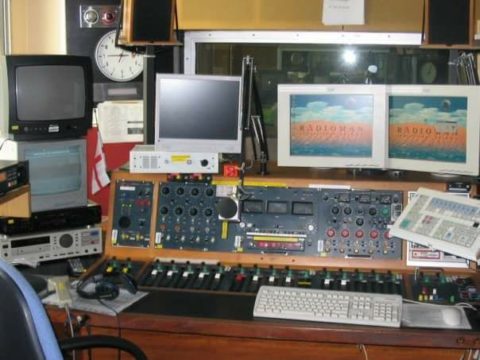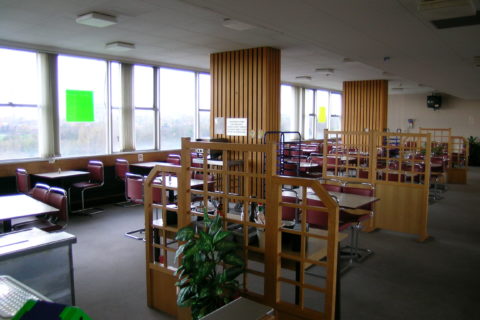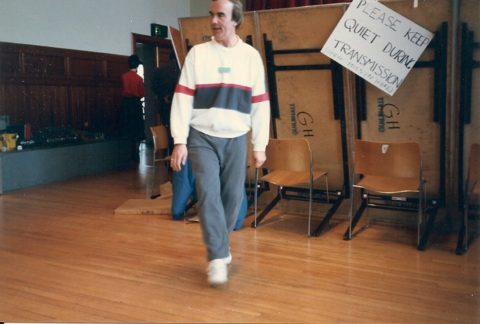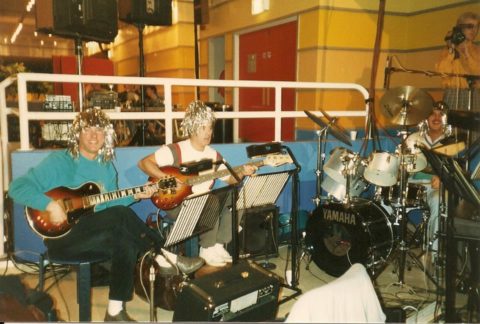
Photo from Rod Fawcett, no reproduction without permission
Radio WM engineer, Rod Fawcett, standing proudly by the radio car, in July 1983. It looks like the photo was taken in the car park at Pebble Mill, round the back of the garage.
The following comments were left on the Pebble Mill Facebook page:
Keith Butler: ‘I was attached as an engineer to radio WM in 1983, and it was me who went down to Brookmans Park to collect this radio car and drive it back to Pebble Mill.’
Bob Chesworth: ‘UHF transmitter to that aerial on top of the mast, VHF comms (Storno?)to and from base.Air compressor to drive mast up (with safety overides!) No radio mic,just a drum of multi possibly to a Diggles mic (or was that too early?) Probably a 1.6 litre engine (some of the “County” stations had a 2 litre version) A lot of the vehicles had number plates reflecting the transmitter, Lincs was A219 SUL ‘cos we were 219 on medium wave. Joined up thinking from Transport courtesy of Peter Higgins I believe.’
Paul Hunt: ‘I came across the Cortina radio car when I did a stint at Radio Lincolnshire. Bob Chesworth demonstrated how putting the Moseley UHF transmitter into high power doubled the flashing speed of the cars indicators!!’
Keith Brook (Scouse): ‘Before I became a Pebble Mill cameraman, I worked at Radio Merseyside in the late 60s.
Their radio car was a Ford Cortina and the whole of the cargo area filled with very heavy car batteries to power the transmitter.
This made driving the thing great fun especially around corners when we were trying to stay close to a blue light police escort!
Trying to get a signal back was problematic and the car had to be inched backwards or forwards until the signal strength was good enough.
There was a switch at the base of the antenna to inhibit driving with it extended. To perform the ‘inching’ procedure, the switch was over-ridden with an old penny piece wedged between the contacts!!
Great fun!’
Marc Price: ‘I worked at WM from 1989 – 1993. The radio car was an Austin Montego in those days. Just before I left, I drove the Montego down to West London (can’t remember the site name but think it was where all the old broadcast kit went when it was decommissioned). I was only a few miles away from my destination when I managed to crash it! Think the replacement was a Ford Sierra.’
Simon Pattern: ‘Or as we called it at Radio York – the Montenogo.
If I recall, the Sierra replacements were dreadful to drive, the positioning of the technical gear left them with the oddest centre of gravity, which in turn made them act like a tractor pulling a herd of cattle once you got above 30mph!’
Chris Livingstone: ‘Didn’t Manchester have a similar version? I remember having to stand on the sill and pull the mast down for the last few inches so that it could be driven. Also, the mast on the top of Piccadilly plaza had to be rotated from the studio in order to pick up the signal. There were “black spots” too where a signal just couldn’t get through’
Andrew Thorman: ‘I think the car was eventually written off by a newsroom hack on the M5 having been “lent” him to get home.’
Ian Oakland: ‘I remember that being the ‘new radio car’’
Simon Pattern: ‘How can any radio car discussion not mention the Storno “dudderly dups”!’
Marc Clements: ‘The golden age of wm!’
Paul Andersson: ‘Whilst at Cleveland our radio car was a Hillman Hunter estate!’
Chris Bell: ‘very similar to the one we had. If I remember correctly it worked on phantom cue with station output coming from the car radio of all things!!! The mast had a small compressor but the cut out to stop you driving away with the mast up had a habit of failing!!!! Happy days eh?’
Kevin Keene: ‘Some interesting discussion on here. I remember in ’96 taking the vintage Radio Humberside OB van home for an early live at Mappleton cliffs. At 4am I went out to find I’d been blocked in. Spent 15 minutes doing short back and forth movements to get out with the loud reversing hooter coming on each time. The neighbours didn’t block me in a second time.’
Save
Save
Save
Save
Save
Save









